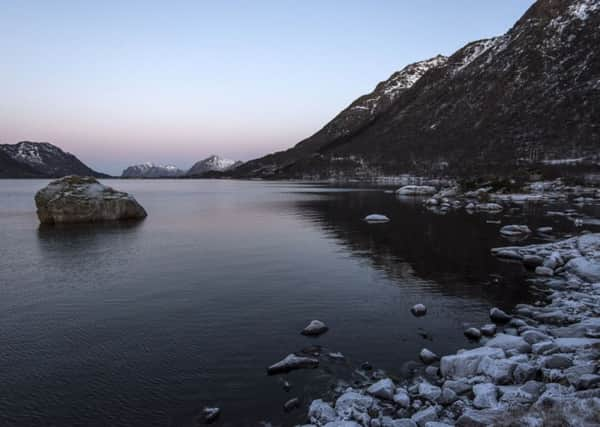Travel review: Norway's Vesteralen islands


When technical troubles forced British astronaut Tim Peake to abandon his first spacewalk, I’m certain he was appreciative of a competent crew.
Unfortunately, I can’t say the same about my own space shuttle, where the crew is furiously fiddling with touchscreens as we hurtle into a solar storm. Alarms fire, systems fail and we hit blackout.
Advertisement
Hide AdAdvertisement
Hide Ad“Sorry,” sheepishly whispers our Chief Navigator, a mid-50s woman from Cincinnati who could barely find her way into our mission regulation overalls.
In reality, we haven’t left the Earth; our intergalactic adventure is part of Spaceship Aurora, a visitor attraction at the Andoya Space Centre in Norway’s Vesteralen archipelago, the ideal place to see the Northern Lights.
Although just south of popular Tromso, Vesteralen attracts a fraction of the visitors who descend on the aurora capital; that’s largely down to journey time (it’s at least two flights from the UK).
Yet a stirring landscape of serrated mountain peaks, an abundance of wildlife and – crucially – few people, make this one of Europe’s best kept winter secrets.
Advertisement
Hide AdAdvertisement
Hide AdOne of the draws is whale watching, which has long been a popular activity in Andenes, a small fishing port at the northern tip of Andoya Island. More recently, increasing numbers of orcas have been arriving from mid-December to February to feed on herring.
Acclaimed zoologist Mark Carwardine is chartering the company’s M/S Reine vessel for his new whale watching and northern lights tours. Different level viewing platforms offer flexibility for photographers, and an indoor cabin, toilet facilities and constant supply of tea and biscuits make the two- to three-hour trips extremely comfortable.
We leave port at 10am as slithers of tangerine light creep across the sky, silhouetting a flock of kittiwakes in flight. In early January, the sun doesn’t even rise above the horizon; instead the heavens glow from explosive reds to chilling blues, as dawn segues into dusk.
Within minutes, a pod of 10 orcas has appeared, their large dagger-like dorsal fins mirroring Andoya’s jagged coastline as they porpoise through the Norwegian Sea.
Advertisement
Hide AdAdvertisement
Hide AdWe’re captivated by the display until some new arrivals threaten to steal the show – a pair of humpbacks and even a mighty sperm whale. The M/S Reine uses two hydrophones to track whale clicks, and when the creatures surface and fall silent, crew use their eyes.
Switching off the engine, we drift slowly behind a creature twice the length of a double-decker bus. His gentle blows fall into a hypnotic rhythm, then he slowly dives, creating a cascade of water as his tail fluke fans the burning sky.
Marten Bril from Sea Safari Andenes runs daily trips in an RIB boat and also offers an option for hardy souls to dive with killer whales. He relies on a spotter based at the Andenes lighthouse, using binoculars and communicating sightings by mobile phone.
I can barely move in the insulation suit necessary for our wet and bumpy excursion, but the opportunities we have to get close to the orcas are unparalleled. One large male greets me at eye-level before ducking underneath our boat and by the time we return from our three-hour trip, it’s almost dark. That gives us ample time to rest in the grand 1900s fishing house, which Martin rents out, before setting off on a northern lights hunt.
Advertisement
Hide AdAdvertisement
Hide AdWe buy crampons and climb the snow-covered Ramnan Mountain using a steep but easily navigable path. The location is not listed on maps, but is identifiable by lasers beaming from the Alomar Observatory and the views are astonishing.
The lights accompany us south to Bo, an even more scenic island in the Vesteralen archipelago, where crystallised forests sparkle like diamonds.
Originally from Cornwall, Ian Robins manages Huset Pa Yttersiden, a small collection of waterfront fishermen’s cabins, with his Norwegian wife, Ann Karina.
His passion is photographing the area’s resident white-tailed sea eagles, which he fondly refers to as his “house pets”, and he guides guests on winter safaris
Advertisement
Hide AdAdvertisement
Hide AdSetting off mid-morning, we weave between rocky islets. Ian tosses a frozen fish into the water and waits for Europe’s largest raptor to arrive.
With a wingspan of almost three metres, it’s easy to spot. After circling the boat for a few seconds, the graceful bird swoops down, talons outstretched, to grab its fish.
“What a creature,” gasps Ian.
As days grow longer, shifting landscapes are bathed in an ever-changing light, meaning no one place appears the same.
It’s a natural beauty that defies any scientific or space age explanation.